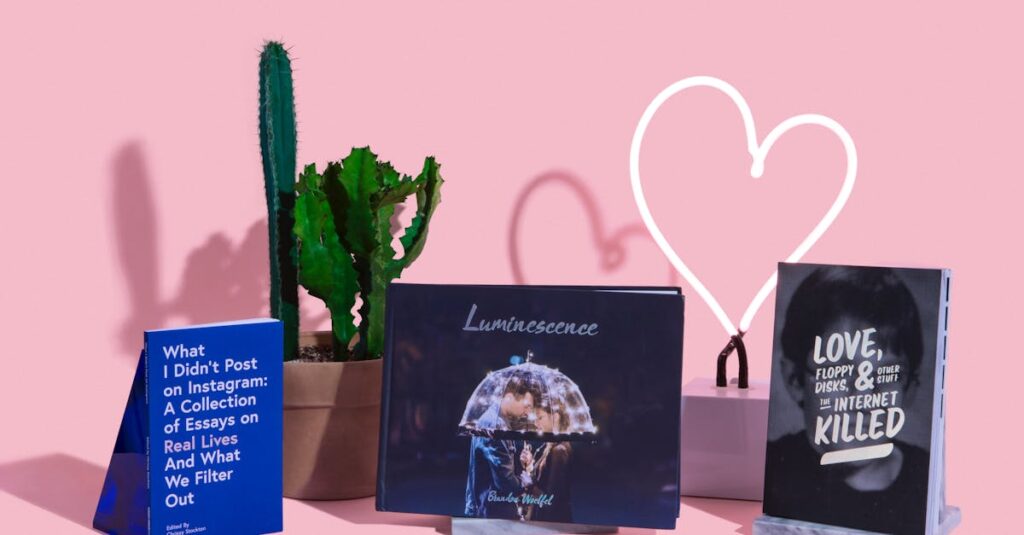As a creative writing instructor for over a decade, I’ve seen countless portfolios that showcase writers’ talents and potential. A well-crafted creative writing portfolio can open doors to publishing opportunities, academic programs, and professional writing careers.
I’ll share some inspiring examples of creative writing portfolios that have caught my attention and helped writers achieve their goals. Whether you’re applying to MFA programs, seeking literary representation, or building your online presence, these examples will guide you in presenting your work effectively. From traditional print collections to modern digital platforms, I’ve gathered diverse portfolio formats that demonstrate the power of thoughtful curation and professional presentation.
Creative Writing Portfolio Examples
- A creative writing portfolio should include 3-5 different writing genres, a table of contents, author bio, publication credits, writing statement, and contact information
- Digital portfolios offer advantages like easy updates, multimedia integration, and analytics tracking, while physical portfolios provide tangible presentation and direct formatting control
- Writing samples should include 2-3 short stories (1,500-7,500 words), 1-2 flash fiction pieces (under 1,000 words), 5-7 poems, and 2-3 creative nonfiction pieces (1,500-3,000 words)
- Portfolios can be organized thematically (by genre, mood, subject) or chronologically (by creation, publication, or submission dates)
- Professional presentation requires clean typography, consistent formatting, proper spacing, and clear navigation elements
- Popular portfolio platforms include Clippings.me, Contently, Journo Portfolio, WordPress, and Wix, offering various features for digital showcase
What Is a Creative Writing Portfolio?
A creative writing portfolio is a curated collection of an author’s best written works showcasing their writing abilities skills across different genres styles. This professional compilation serves as a personal archive demonstrating writing range versatility talent.
Essential Elements to Include
A complete creative writing portfolio contains these core components:
- Writing samples from 3-5 different genres (poetry fiction creative nonfiction)
- Table of contents with clear section organization
- Brief author bio highlighting relevant credentials publications
- Publication credits listing where works appeared in print or online
- Writing statement explaining artistic vision creative process
- Contact information including professional email social media links
Digital vs Physical Portfolios
Digital portfolios offer these distinct advantages:
- Easy updating of content through content management systems
- Multimedia integration with audio video visual elements
- Analytics tracking of visitor engagement metrics
- Interactive features like commenting sharing capabilities
- Mobile-friendly accessibility across devices platforms
- Tangible presentation during in-person meetings interviews
- Professional binding printing options for formal submissions
- Direct control over layout formatting presentation
- Ability to include original documents handwritten notes
- No technical requirements for viewing accessing materials
| Portfolio Type | Update Speed | Cost Range | Distribution |
|---|---|---|---|
| Digital | Instant | $0-50/month | Unlimited |
| Physical | 2-3 days | $30-200/copy | Limited |
Types of Writing Samples to Showcase
A creative writing portfolio demonstrates range through diverse writing samples. These samples establish expertise across multiple genres while maintaining a cohesive artistic voice.
Short Stories and Flash Fiction

Short fiction pieces showcase storytelling abilities in condensed formats. I recommend including 2-3 complete short stories (1,500-7,500 words) plus 1-2 flash fiction pieces (under 1,000 words) that demonstrate:
- Compelling character development in limited space
- Distinct narrative voices across different pieces
- Mastery of plot structure within tight word counts
- Genre versatility through literary or commercial styles
Poetry Collections
Poetry selections highlight command of language and imagery. An effective poetry portfolio section contains:
- 5-7 poems representing different forms (sonnets free verse villanelles)
- At least 1 longer narrative poem (20+ lines)
- Examples of both traditional meter rhyme schemes
- Themed sequences showing sustained poetic exploration
- Experimental pieces demonstrating innovation
Creative Nonfiction Pieces
Creative nonfiction combines factual content with literary techniques. Key components include:
- 1-2 personal essays (1,500-3,000 words)
- Literary journalism samples with research elements
- Memoir excerpts featuring scene setting description
- Nature writing or travel pieces with sensory details
- Hybrid forms blending genres experimental approaches
| Genre | Recommended Count | Word Range |
|---|---|---|
| Short Stories | 2-3 pieces | 1,500-7,500 |
| Flash Fiction | 1-2 pieces | Under 1,000 |
| Poetry | 5-7 poems | 10-50 lines each |
| Creative Nonfiction | 2-3 pieces | 1,500-3,000 |
How to Organize Your Portfolio
A well-organized creative writing portfolio creates a strong first impression and showcases writing evolution effectively. I’ve identified two primary organizational approaches that maximize portfolio impact.
Thematic Organization
Thematic organization groups writing pieces by shared concepts themes styles or genres. I arrange related works in distinct sections such as:
- Create genre-specific collections (Fiction Poetry Creative Nonfiction)
- Group pieces by mood or tone (Dark Humorous Contemplative)
- Organize by subject matter (Nature Technology Relationships)
- Cluster works exploring similar themes (Identity Loss Transformation)
- Sort by writing style (Experimental Traditional Minimalist)
Chronological Structure
Chronological organization presents writing samples based on their creation completion or publication dates. Here’s how I structure chronological portfolios:
- Place newest works first for highlighting current skill level
- Organize published pieces by publication dates
- Group contest entries submissions by competition deadlines
- Arrange academic works by semester completion
- Sort commissioned pieces by client delivery dates
| Timeline Element | Format Example |
|---|---|
| Publication Date | Month Year |
| Contest Entry | Season Year |
| Academic Work | Semester Year |
| Client Project | Quarter Year |
Professional Portfolio Examples
I’ve curated exemplary creative writing portfolios that demonstrate effective presentation strategies across different professional contexts. These portfolios showcase distinct approaches tailored to specific career objectives in academia and publishing.
Academic Portfolios
Academic portfolios emphasize scholarly achievement alongside creative work. Here’s what successful academic portfolios contain:
- Research statements linking creative practice to academic theories
- Teaching philosophy documents (1-2 pages) highlighting pedagogical approaches
- Course syllabi samples from writing workshops or literature courses
- Published works in peer-reviewed literary journals
- Conference presentations related to creative writing
- Academic credentials formatted in CV style
- Writing samples organized by genre categories:
- Poetry collections (15-20 pages)
- Short fiction (2-3 complete stories)
- Literary criticism (10-15 pages)
- Query letters for specific manuscripts
- Book proposals with market analysis
- Writing samples in consistent genre categories:
- Genre fiction: 3 polished chapters
- Literary fiction: 2-3 complete stories
- Poetry: 10-12 poems in similar styles
- Publication credits listed chronologically
- Platform statistics:
- Social media following numbers
- Newsletter subscriber counts
- Website traffic metrics
- Author brand elements:
- Professional headshot
- Author logo
- Style guide
- Marketing materials:
- Book cover concepts
- Press kit components
- Author website screenshots
Best Practices for Presentation
Creative writing portfolio presentation combines visual appeal with practical organization to enhance readability and engagement. These guidelines optimize the portfolio’s impact across digital and print formats.
Design and Layout Tips
Clean typography establishes hierarchy through 2-3 complementary fonts for headings and body text. I recommend using:
- 12-point serif fonts (Garamond, Georgia) for reading passages
- 14-16 point sans-serif fonts (Helvetica, Arial) for section headings
- 1.5-2.0 line spacing to improve readability
- Left alignment for consistent text flow
- Navigation elements like page numbers headers footers
- White space margins of 1-1.5 inches on all sides
- Consistent formatting across all documents
Writing Sample Length
Sample lengths vary by genre to demonstrate range while maintaining reader engagement:
| Genre | Recommended Length | Number of Pieces |
|---|---|---|
| Short Stories | 1,500-7,500 words | 2-3 pieces |
| Flash Fiction | Under 1,000 words | 1-2 pieces |
| Poetry | 1-3 pages each | 5-7 poems |
| Personal Essays | 2,000-4,000 words | 1-2 pieces |
| Novel Excerpts | 3,000-5,000 words | 1 piece |
- Clear title placement
- Genre identification
- Publication status if applicable
- Brief context note (25-50 words)
- Page breaks between samples
Portfolio Platforms and Tools

Digital platforms enhance the presentation of creative writing portfolios through customizable layouts interactive features global accessibility. Here’s a comprehensive overview of available options for showcasing your work online.
Online Portfolio Websites
Professional portfolio platforms offer specialized features for writers to display their work:
- Clippings.me: Supports multiple content formats includes analytics tracking offers a free tier for up to 10 writing samples
- Contently: Features a clean interface displays publication logos integrates with LinkedIn
- Journo Portfolio: Provides custom domain options allows PDF uploads includes mobile-responsive designs
- WordPress.com: Offers extensive customization options includes blogging capabilities supports multimedia content integration
- Wix: Features drag-and-drop design tools provides writing-specific templates enables contact form integration
| Platform | Free Tier Storage | Monthly Cost | Custom Domain |
|---|---|---|---|
| Clippings.me | 10 samples | $9.99 | Yes |
| Contently | Unlimited | Free | No |
| Journo Portfolio | 10 articles | $7.99 | Yes |
| WordPress.com | 3GB | $4.99 | Yes |
| Wix | 500MB | $14.99 | Yes |
- GitHub Pages: Offers free hosting supports markdown formatting enables version control
- WordPress.org: Provides full site ownership allows unlimited customization requires technical knowledge
- Static Site Generators:
- Hugo: Features fast build times includes writing-focused themes
- Jekyll: Offers simple content management integrates with GitHub Pages
- Gatsby: Supports modern web features enables dynamic content loading
| Platform | Setup Complexity | Monthly Hosting Cost | Technical Skills Required |
|---|---|---|---|
| GitHub Pages | Low | Free | Basic HTML/Markdown |
| WordPress.org | Medium | $3-20 | PHP/MySQL |
| Static Generators | High | $0-10 | HTML/CSS/JavaScript |
A Living Document That Grows and Evolves With Your Writing Journey
Creating a standout creative writing portfolio is essential for any writer looking to make their mark in the industry. I’ve shared my expertise on portfolio types presentation strategies and digital tools to help you showcase your best work effectively.
Whether you’re aiming for academic recognition or seeking publication opportunities your portfolio should reflect your unique voice and professional goals. Remember that a well-crafted portfolio is a living document that grows and evolves with your writing journey.
Take time to curate your work thoughtfully and choose the format that best serves your needs. With these insights and examples I’m confident you’ll be able to build a portfolio that opens doors and advances your writing career.



